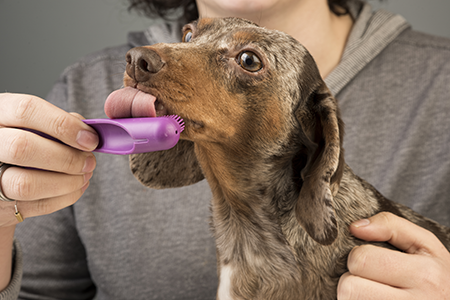
This condition is caused by a buildup of plaque on the teeth and formation of bacteria around the gums. Over time, periodontal disease can lead to a range of health concerns, including tooth loss, systemic infections and internal organ damage.
The sad reality is that 85% of all pets develop dental disease by age three. Fortunately, it is entirely possible to keep your pet’s teeth in tip-top shape with proper oral care. Yearly professional teeth cleaning for your dog or cat is important, but it is not enough. Below are steps you can begin taking today to ensure good dental health for your pet.
Pet Dental Care & Cleaning at Home
The best way to care for your pet’s teeth at home is by getting into the habit of regular brushing. Daily brushing would be excellent, but if this is an unrealistic goal for you and your pet, aim for at least 2-3 times per week. It only takes a few minutes, and can prevent your beloved pet from developing serious health concerns over time.
The only tools you will need are a soft bristled toothbrush and a pet-formulated toothpaste. For small pets like cats a finger brush may work best. Toothpastes for pets are available in tasty flavors like poultry, beef and seafood – find one your pet loves, and you can transform brushing from a chore into a treat.
It may take some time for your dog or cat to get used to having their teeth brushed. Take things slowly to ensure they are comfortable with the process, and the experience will soon become easier for both of you. At the beginning, you may only be able to brush a few teeth at a time – baby steps are better than no steps!
Some pets will be more resistant to brushing than others, even with regular practice. In these cases, it is important to supplement with dental-formulated foods, water additives and treats, which can round out your pet’s complete oral care plan. These products are specifically designed to remove plaque buildup, and may also freshen your pup or kitty’s breath.
Professional Pet Teeth Cleaning
In addition to regularly cleaning your pet’s teeth at home, it is essential to schedule professional cleanings on a yearly basis. Annual dental cleanings should begin when your cat or dog is around 1-2 years old.
Your veterinarian has a trained eye that will quickly be able to identify signs of dental disease, such as inflamed gums, bleeding or yellowish buildup on teeth. Veterinary offices are stocked with the right tools and technology to clean those hard-to-reach spaces in your pet’s mouth, ensuring no nook or cranny gets missed.
Another benefit of having your pet’s teeth cleaned by your veterinarian is that if they notice something isn’t right, they’re equipped to provide treatment onsite. While a standard groomer is great for supplementing your pet’s dental care, they can’t offer that same level of care.
When to See Your Vet
Your dog or cat is very good at hiding pain, which can make noticing a serious dental problem tricky. If you observe any of these tell-tale signs of dental disease, it would be wise to schedule a consultation with your vet right away:
- Chronic bad breath
- Inflamed, red or bleeding gums
- Yellow-brown tartar on teeth
- Difficulty eating or chewing
- Blood left behind on chew toys
- Excessive saliva
Oral hygiene is a critical part of your pet’s overall health and wellbeing, just as much as proper nutrition and exercise. If your dog or cat is overdue for a professional dental cleaning or checkup, don’t wait – find a location near you and schedule an appointment today.